Transforming your outdoor space begins with choosing the right garden layout that reflects your style, meets your functional needs, and enhances your home's appeal. Garden layouts serve as the foundation for creating organized, beautiful, and purposeful outdoor environments. Whether you prefer structured geometric patterns or flowing organic designs, the layout determines how visitors move through your space and how plants interact with architectural elements. From formal symmetrical arrangements to casual cottage-style borders, each layout approach offers unique benefits and aesthetic qualities. The key lies in selecting a design that complements your lifestyle, maintenance preferences, and the natural characteristics of your property while creating outdoor spaces that bring you joy throughout the seasons.
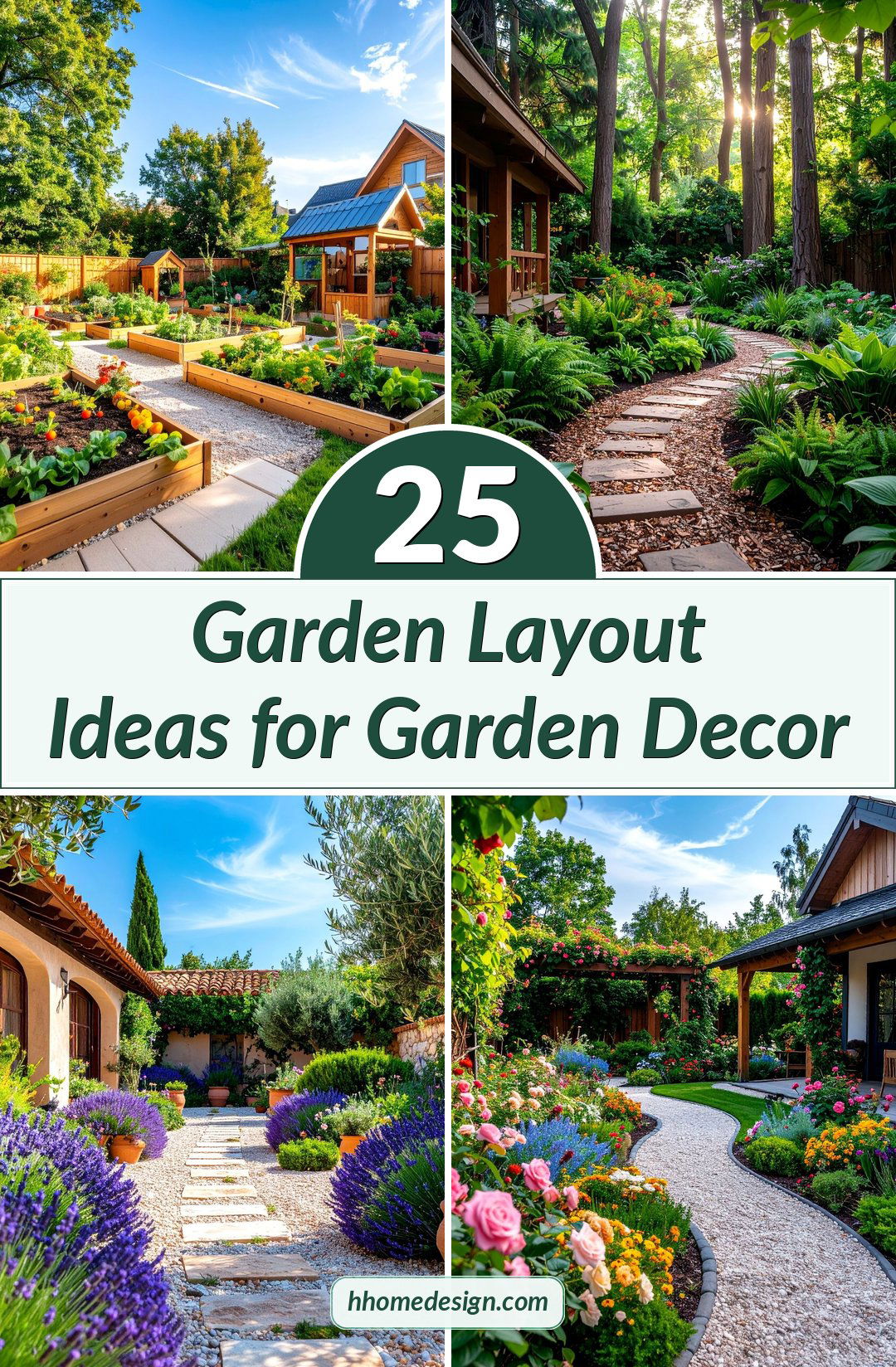
1. Formal Symmetrical Garden Layout with Central Axis
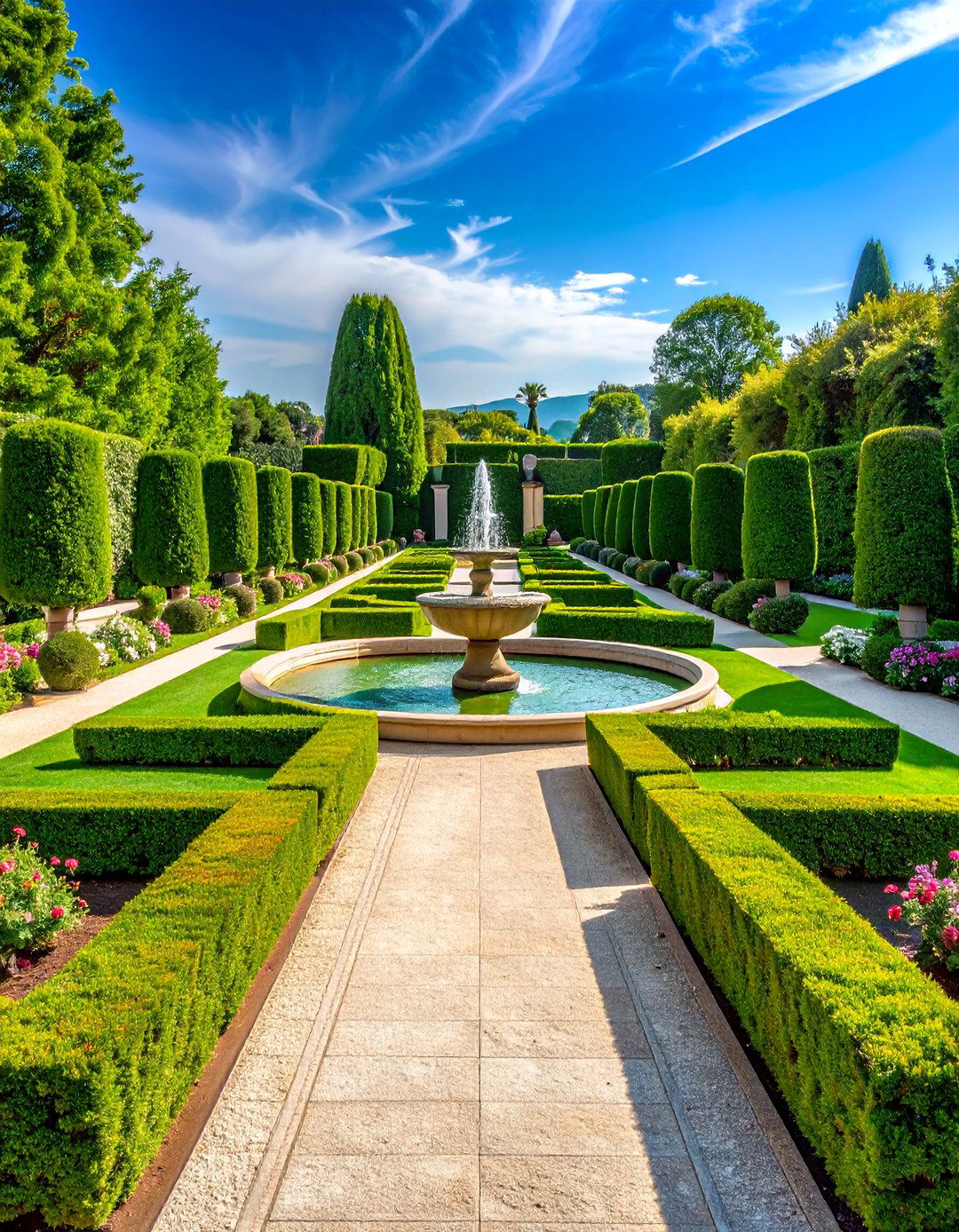
Formal symmetrical gardens create elegant outdoor spaces through balanced, mirror-image designs centered around a main pathway or axis. This classic layout features geometric plant beds, neatly trimmed hedges, and structured pathways that lead to focal points like fountains or statuary. The design emphasizes precision and order, with matching elements on both sides of the central line. Box hedges, topiaries, and carefully maintained lawns provide year-round structure, while seasonal flowers add controlled bursts of color. This layout works exceptionally well for front gardens and entertaining areas, offering timeless sophistication that complements traditional and contemporary architecture. Regular maintenance ensures crisp edges and maintains the refined aesthetic that defines this distinguished garden style.
2. Cottage Garden Layout with Abundant Mixed Borders
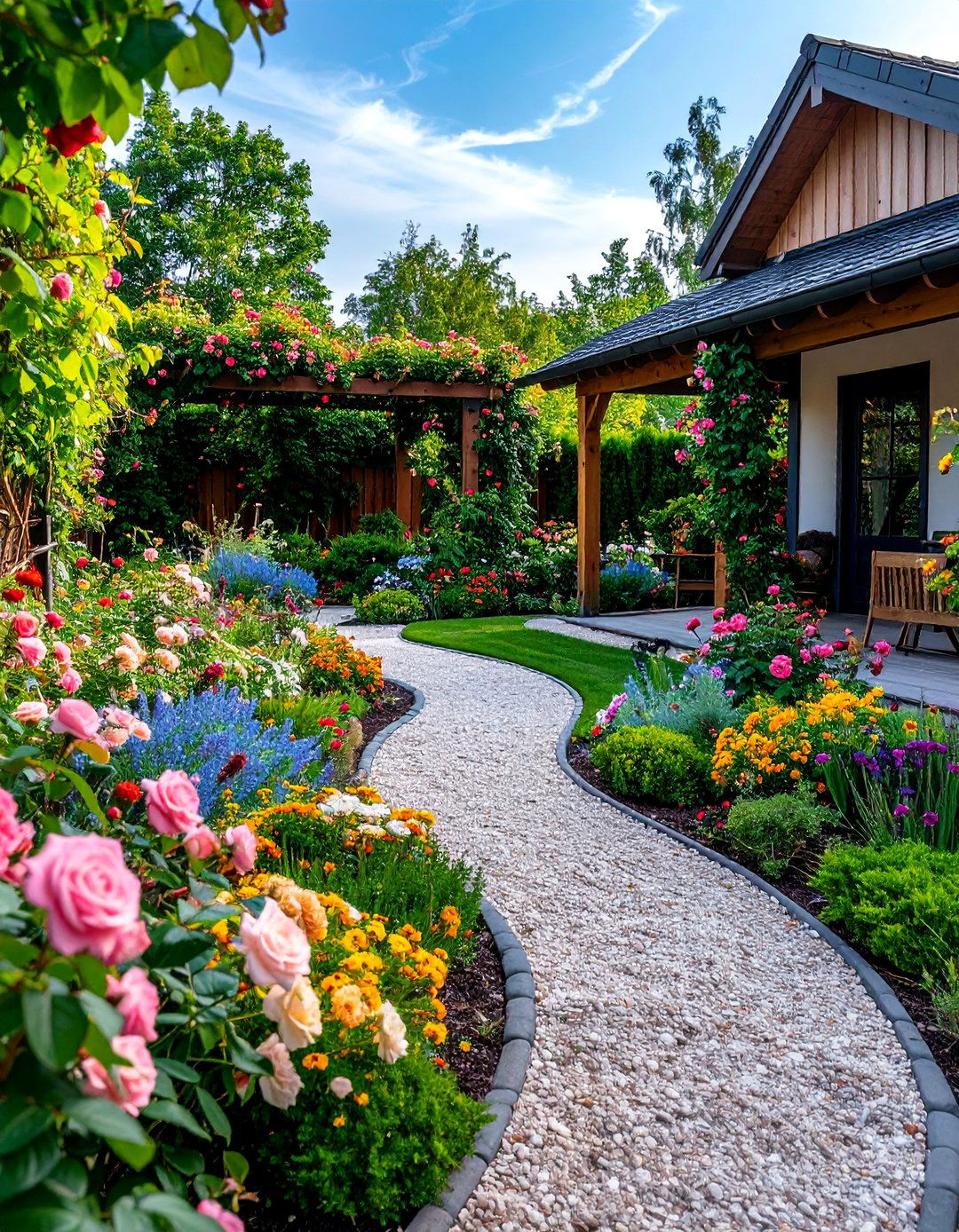
Cottage gardens embrace informal abundance through densely planted borders that overflow with herbs, flowers, and vegetables in charming profusion. This relaxed layout features curved pathways that meander through the space, encouraging exploration and discovery. Plant combinations appear spontaneous yet thoughtful, with roses climbing over arbors, foxgloves towering behind lavender bushes, and edible plants tucked among ornamental varieties. Natural materials like weathered wood, stone, and gravel complement the unpretentious style. The design celebrates the beauty of slightly controlled chaos, where plants spill onto pathways and self-seed throughout the garden. This approach creates a romantic, lived-in atmosphere that evolves naturally over time while providing cutting flowers, herbs, and produce for daily enjoyment.
3. Modern Geometric Garden Layout with Clean Lines
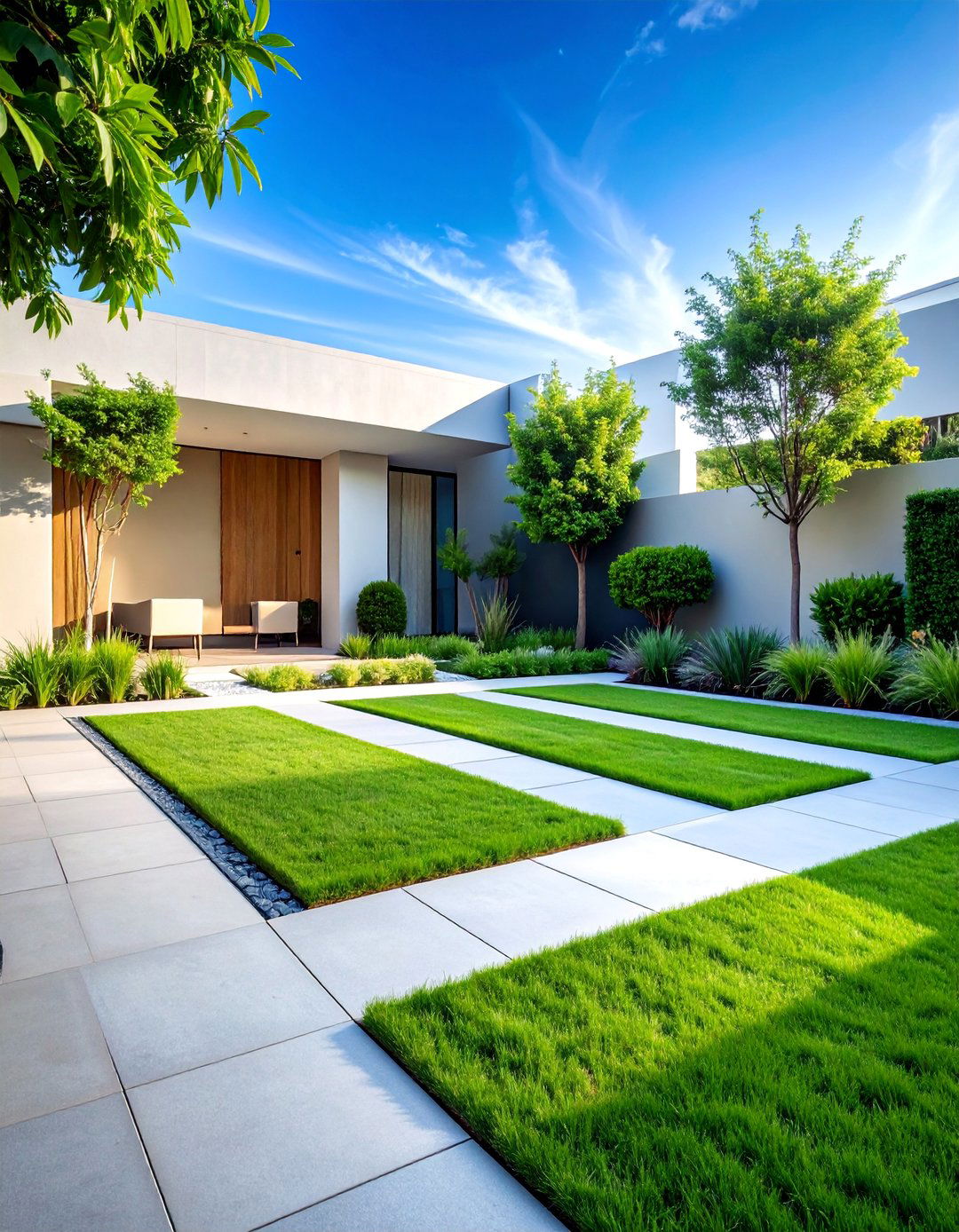
Modern geometric gardens emphasize minimalist sophistication through bold, angular designs that showcase contemporary materials and architectural plants. This layout features large paving slabs arranged in grid patterns, rectangular raised beds, and straight pathways that create strong visual lines. Plant selections focus on structural specimens like ornamental grasses, architectural succulents, and sculptural shrubs planted in organized blocks or strips. The color palette remains restrained, often emphasizing greens with strategic pops of white or purple. Water features, outdoor lighting, and sleek furniture integrate seamlessly with the hardscaping. This design approach complements modern architecture while requiring minimal maintenance, making it perfect for busy homeowners who appreciate sophisticated outdoor spaces with contemporary flair.
4. Japanese Zen Garden Layout with Contemplative Elements
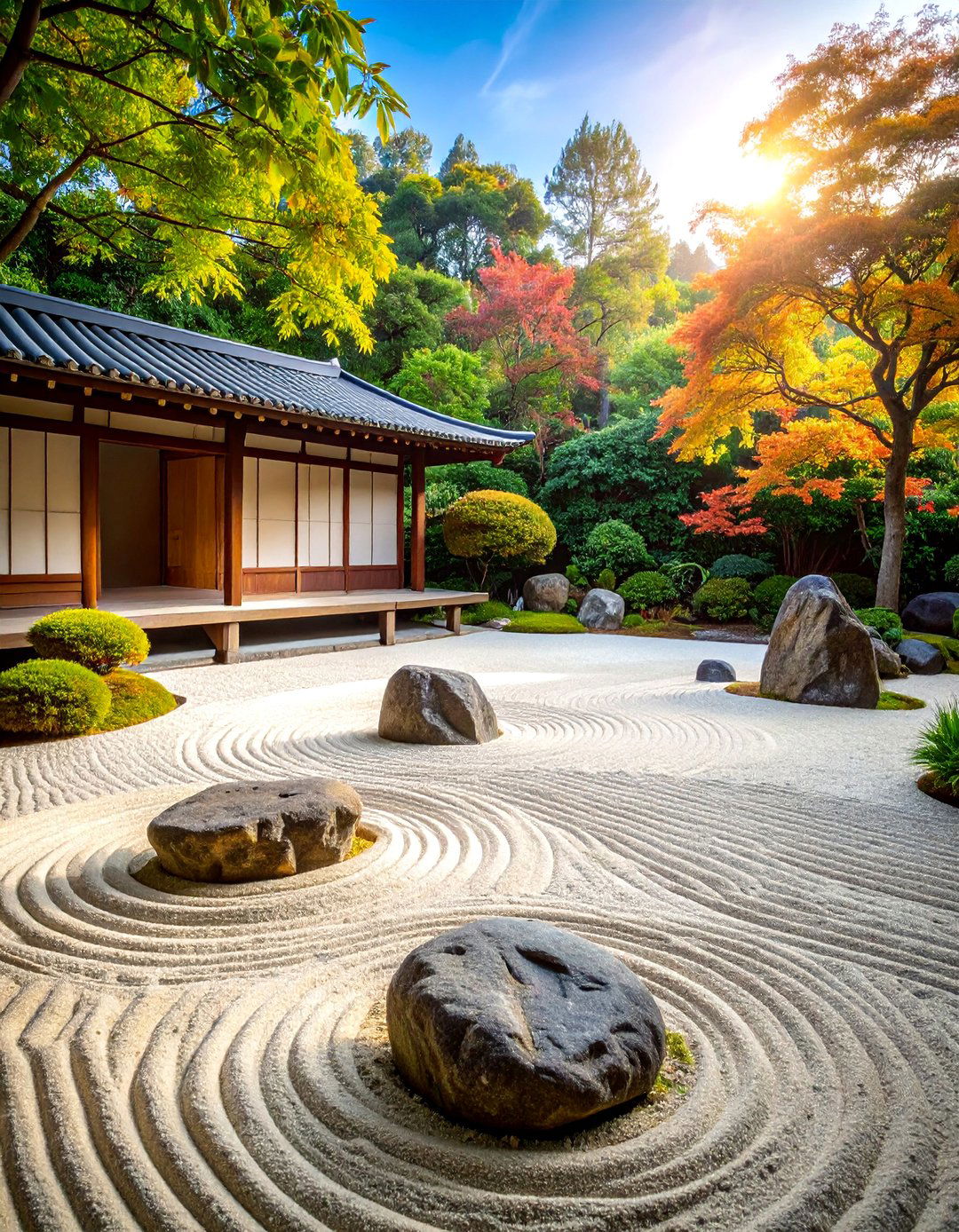
Japanese Zen gardens create tranquil meditation spaces through carefully arranged natural elements that encourage reflection and mindfulness. This minimalist layout features raked gravel or sand patterns representing water, strategically placed stones symbolizing mountains or islands, and limited plant selections including mosses, ferns, and dwarf conifers. Pathways consist of stepping stones that slow movement and encourage contemplation. The asymmetrical design follows principles of balance rather than symmetry, creating visual harmony through careful proportions. Traditional elements like bamboo fountains, stone lanterns, or simple wooden benches provide focal points without overwhelming the serene atmosphere. This layout transforms any space into a peaceful retreat where the act of maintenance becomes meditation, offering respite from busy modern life.
5. Circular Mandala Garden Layout with Radiating Patterns

Circular mandala gardens create harmonious growing spaces through radiating patterns that emanate from a central focal point like a tree, fountain, or seating area. This spiritual layout organizes plants in concentric circles or pie-shaped wedges, often incorporating spiral pathways that encourage meditative movement through the space. The design maximizes growing area while providing easy access to all plants from central pathways. Traditional mandala principles guide plant placement, with taller specimens toward the outside and shorter ones near the center. Herb spirals, flower mandalas, and vegetable wheels all utilize this ancient pattern. The circular form captures rainwater efficiently while creating a sense of unity and completeness. This layout appeals to gardeners seeking both beauty and symbolic meaning in their outdoor spaces.
6. Raised Bed Garden Layout with Defined Growing Areas

Raised bed gardens provide structured growing environments through elevated planting areas that improve drainage, soil quality, and accessibility. This practical layout organizes the garden into distinct rectangular or square sections, each dedicated to specific plant groups or growing seasons. Pathways between beds ensure easy maintenance access while preventing soil compaction. The elevated design extends the growing season, deters pests, and allows for precise soil amendments. Materials range from cedar boards and stone to modern metal systems, all creating defined edges that maintain neat appearances. This layout accommodates companion planting, crop rotation, and succession planting while providing excellent organization for vegetable gardens, herb collections, or flower displays. The structured approach appeals to both novice and experienced gardeners.
7. Kitchen Potager Garden Layout with Edible Focus
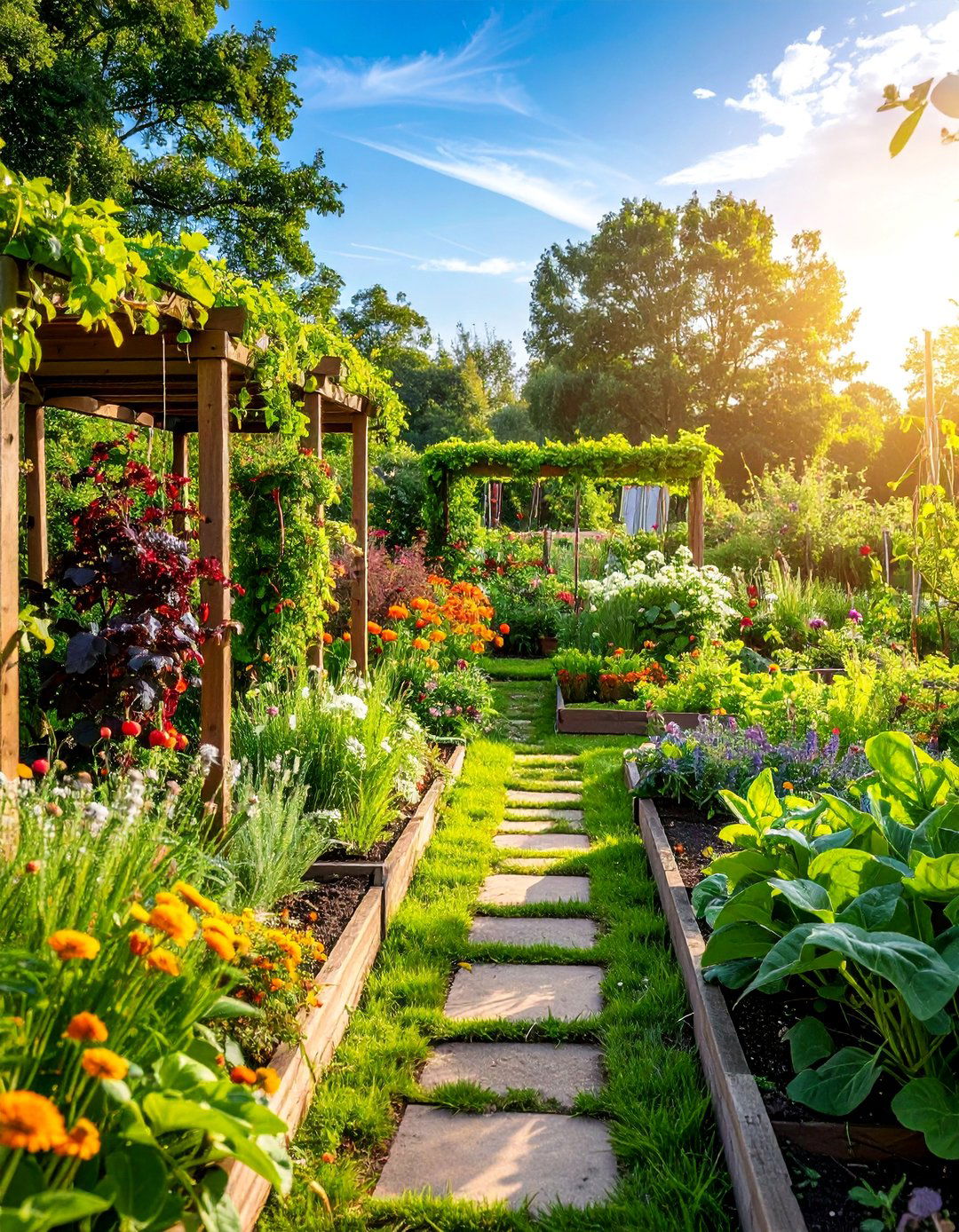
Kitchen potager gardens blend beauty with functionality by combining vegetables, herbs, and flowers in attractive, accessible layouts near the home. This French-inspired design features geometric beds filled with edible plants arranged for both harvest convenience and visual appeal. Pathways provide easy access for daily picking, while trellises and arbors support climbing crops like beans and peas. The layout incorporates companion planting principles, placing basil near tomatoes and marigolds among vegetables. Seasonal succession ensures continuous harvests, while edible flowers add color and attract beneficial insects. Dwarf fruit trees, berry bushes, and perennial herbs provide structure and long-term productivity. This layout transforms food production into an artistic endeavor, creating gardens that nourish both body and soul.
8. Border Garden Layout with Perimeter Plantings
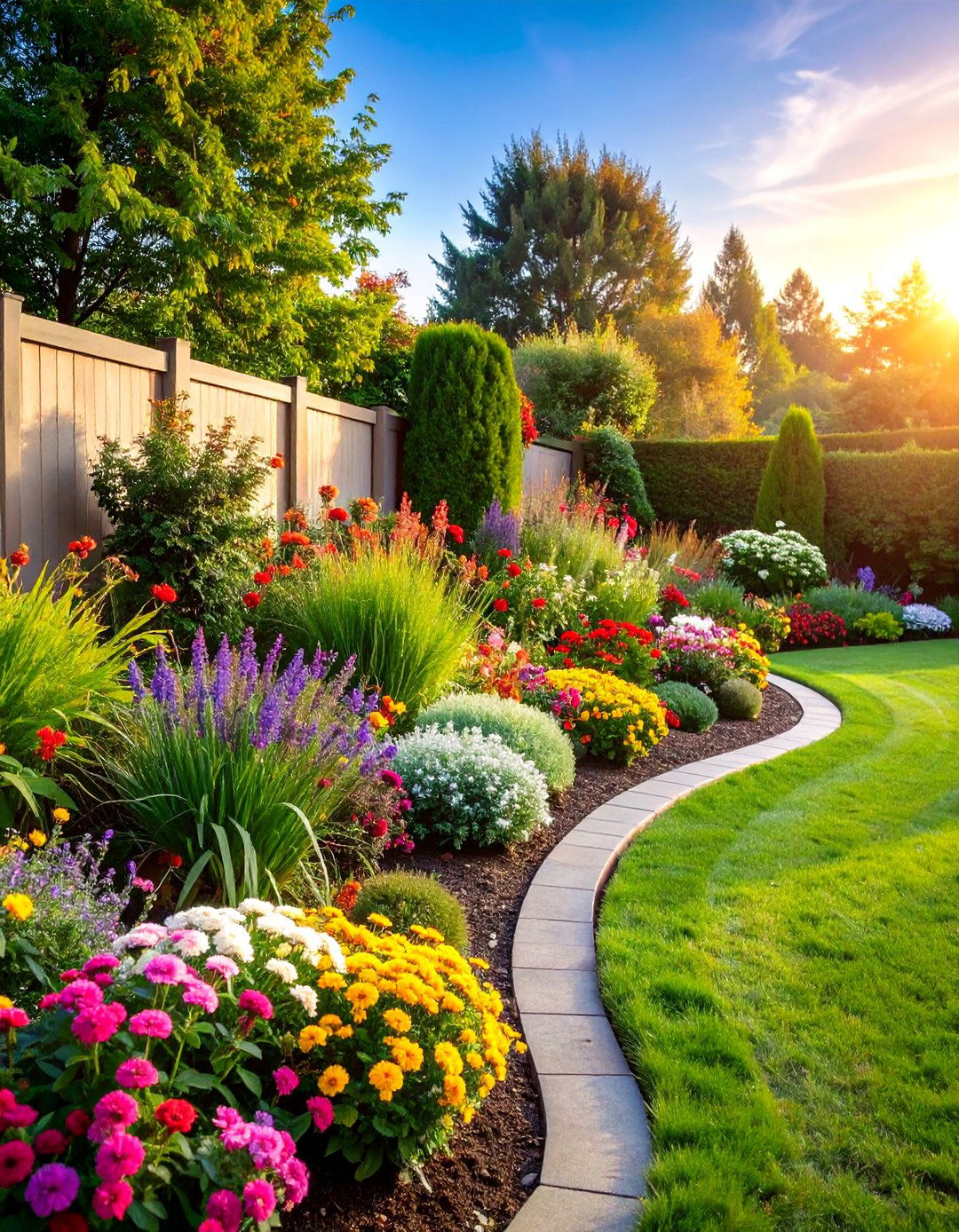
Border gardens utilize the space along property lines, fences, or building foundations to create spectacular displays that frame outdoor areas. This linear layout maximizes impact along edges while leaving central areas open for lawns or patios. Plantings graduate from tall background specimens to medium-height plants and low foreground groundcovers, creating layered compositions with year-round interest. The design accommodates various themes, from colorful perennial borders to evergreen foundation plantings. Curved edges soften harsh lines while strategic plant placement guides the eye along the border's length. This efficient layout provides privacy, screens unsightly views, and creates backdrop plantings for other garden features. Border gardens work especially well in narrow spaces, offering maximum visual impact with minimal ground area requirements.
9. Square-Foot Garden Layout with Grid Organization

Square-foot gardens maximize productivity through intensive planting systems that divide growing areas into precise one-foot squares. This organized layout uses raised beds topped with grid structures that guide plant spacing and simplify garden management. Each square accommodates different crops based on mature plant size, from sixteen radishes in one square to a single tomato plant in another. The systematic approach eliminates traditional rows and walking paths, reducing space requirements by up to fifty percent. Succession planting ensures continuous harvests as squares are replanted throughout the season. This layout appeals to beginning gardeners and those with limited space, providing clear organization and impressive yields. The grid system simplifies planning, planting, and maintenance while teaching proper plant spacing and companion growing techniques.
10. Island Garden Layout with Central Focus Areas
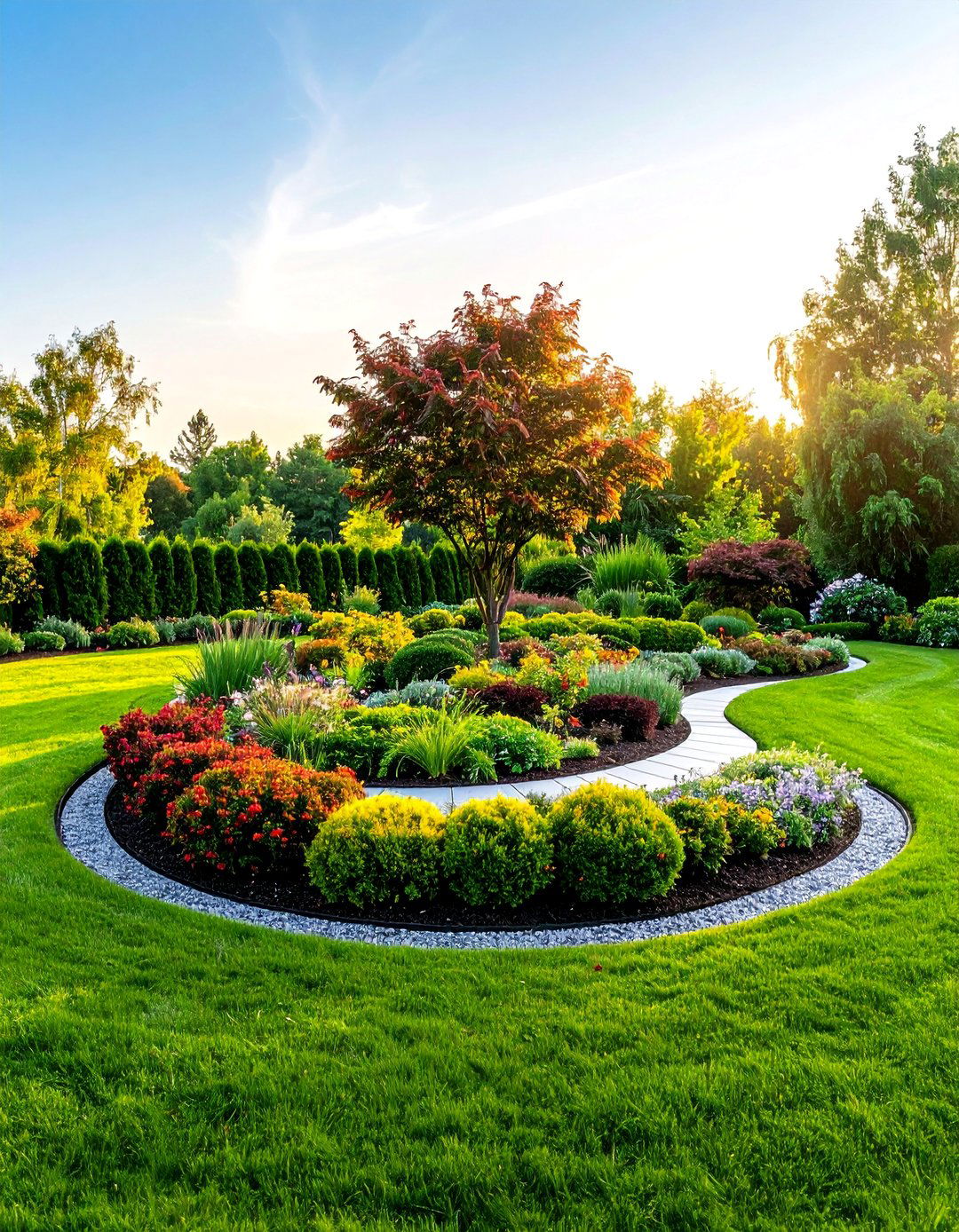
Island gardens create dramatic focal points within larger landscape areas through strategically placed planting beds that can be viewed from multiple angles. This layout features curved, irregular shapes that appear natural within lawn areas or groundcover expanses. Plant selections emphasize specimens with interesting forms, textures, or seasonal changes that maintain appeal throughout the year. The design considers viewing angles from various locations, ensuring attractive compositions from multiple perspectives. Larger islands might include small trees or shrubs as anchor plants, while smaller islands focus on perennial combinations or seasonal displays. This layout adds depth and interest to open areas while providing opportunities for creative plant combinations. Island beds work particularly well in larger properties, breaking up expansive lawn areas with purposeful plantings.
11. Vertical Garden Layout with Upward Growing Space
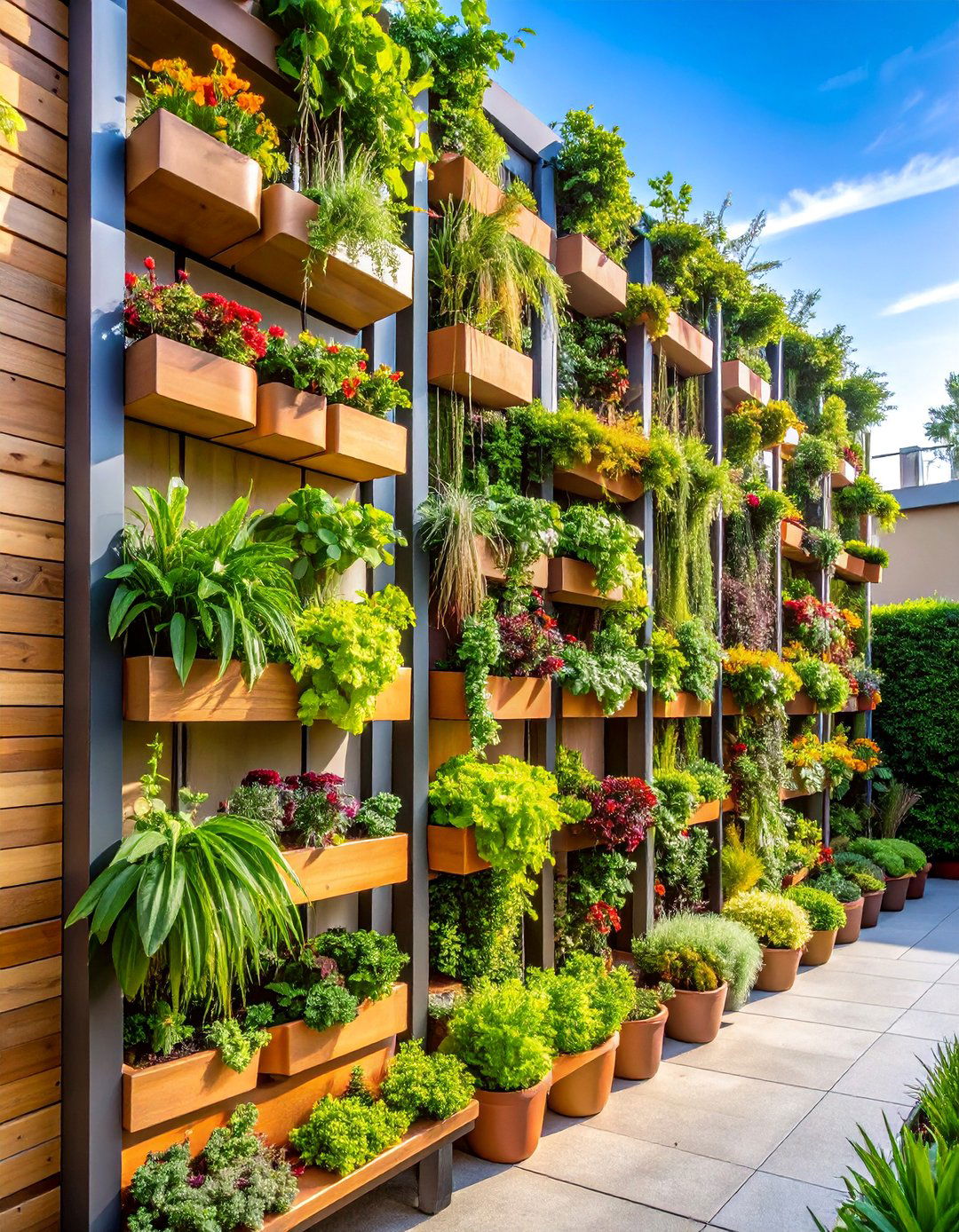
Vertical gardens maximize growing potential by utilizing walls, fences, and structures for upward plant growth. This space-efficient layout incorporates trellises, living walls, hanging planters, and climbing supports to create multi-level growing environments. The design works exceptionally well in small spaces, urban environments, or as privacy screens. Plant selections include climbing vegetables like beans and cucumbers, flowering vines such as clematis and roses, and cascading varieties perfect for hanging containers. Tiered planters and stepped arrangements create additional growing levels while maintaining easy access. This layout transforms bland walls into productive or decorative features while providing wind protection and temperature moderation. Vertical gardens require careful attention to watering and plant support but offer impressive yields and beauty in minimal ground space.
12. Mediterranean Garden Layout with Drought-Tolerant Design
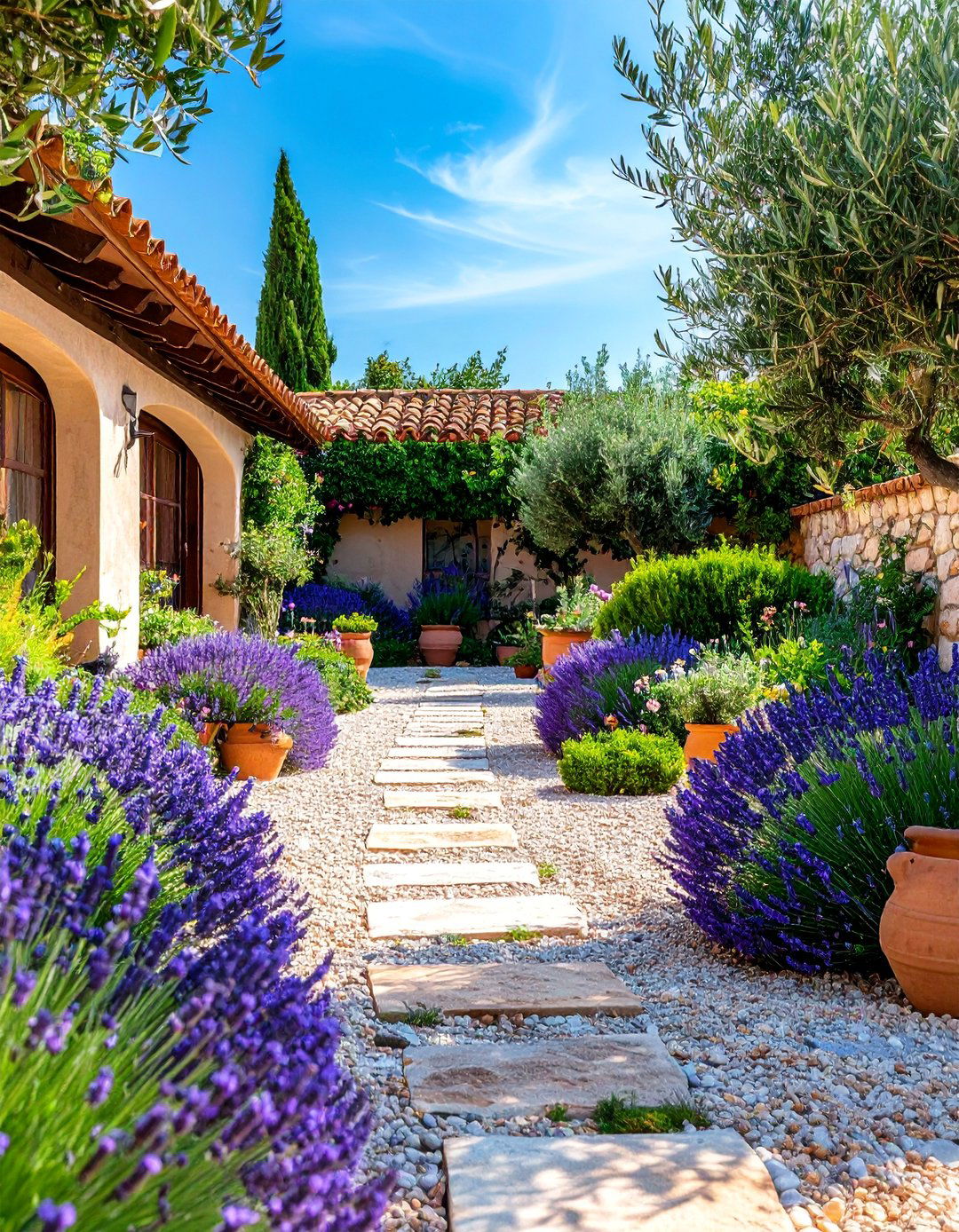
Mediterranean gardens evoke warm, sunny climates through drought-tolerant plants and materials that thrive in hot, dry conditions. This layout features gravel pathways, terra cotta elements, and stone features that complement silver-leafed plants, aromatic herbs, and colorful flowering perennials. The design emphasizes low-water gardening principles with mulched beds, efficient irrigation, and plants adapted to Mediterranean climates. Olive trees, lavender, rosemary, and ornamental grasses provide structure while requiring minimal water once established. Outdoor living areas with pergolas or patios extend the home into the garden. This layout creates relaxed, resort-like atmospheres while addressing water conservation needs. The style works well in arid regions or for gardeners seeking low-maintenance landscapes with distinctive character and year-round appeal.
13. Woodland Garden Layout with Natural Shade Plantings
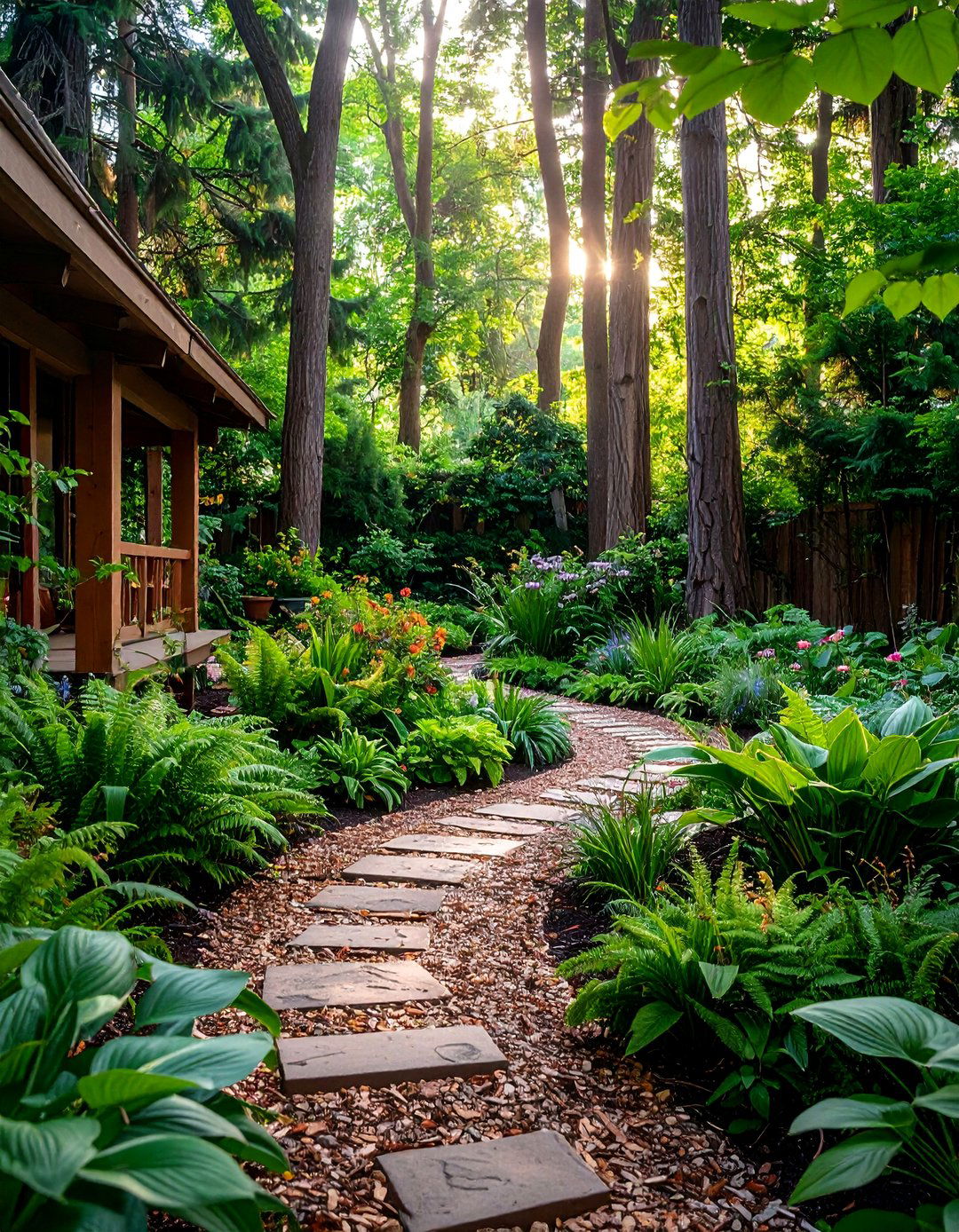
Woodland gardens celebrate the beauty of shaded environments through naturalistic plantings that thrive under tree canopies. This layout mimics forest ecosystems with layered plantings that include understory trees, shrubs, and groundcover plants adapted to low-light conditions. Meandering pathways follow natural contours while clearings provide spots for seating or garden features. Plant selections emphasize native species that support wildlife while providing seasonal interest through foliage, flowers, and berries. The design incorporates natural materials like bark mulch, log borders, and stone accents that blend with the forest aesthetic. This layout appeals to gardeners with mature trees or naturally shaded properties, creating peaceful retreats that require minimal maintenance once established. Woodland gardens provide habitat for birds and beneficial insects while showcasing the subtle beauty of shade plants.
14. Herb Spiral Garden Layout with Functional Design

Herb spiral gardens create productive growing environments through three-dimensional designs that provide multiple microclimates within compact spaces. This permaculture-inspired layout features spiral-shaped raised beds that offer various sun exposures, drainage conditions, and planting zones from base to summit. Mediterranean herbs thrive at the sunny, well-drained top while moisture-loving herbs flourish at the shadier, more protected base. The spiral design maximizes growing area while providing easy access to all plants from a central pathway. Stone or timber construction materials add thermal mass that moderates temperature fluctuations. This layout appeals to cooks and herbalists who want fresh ingredients close to the kitchen. The vertical design creates visual interest while demonstrating sustainable gardening principles that work with natural systems rather than against them.
15. Rain Garden Layout with Water-Wise Features
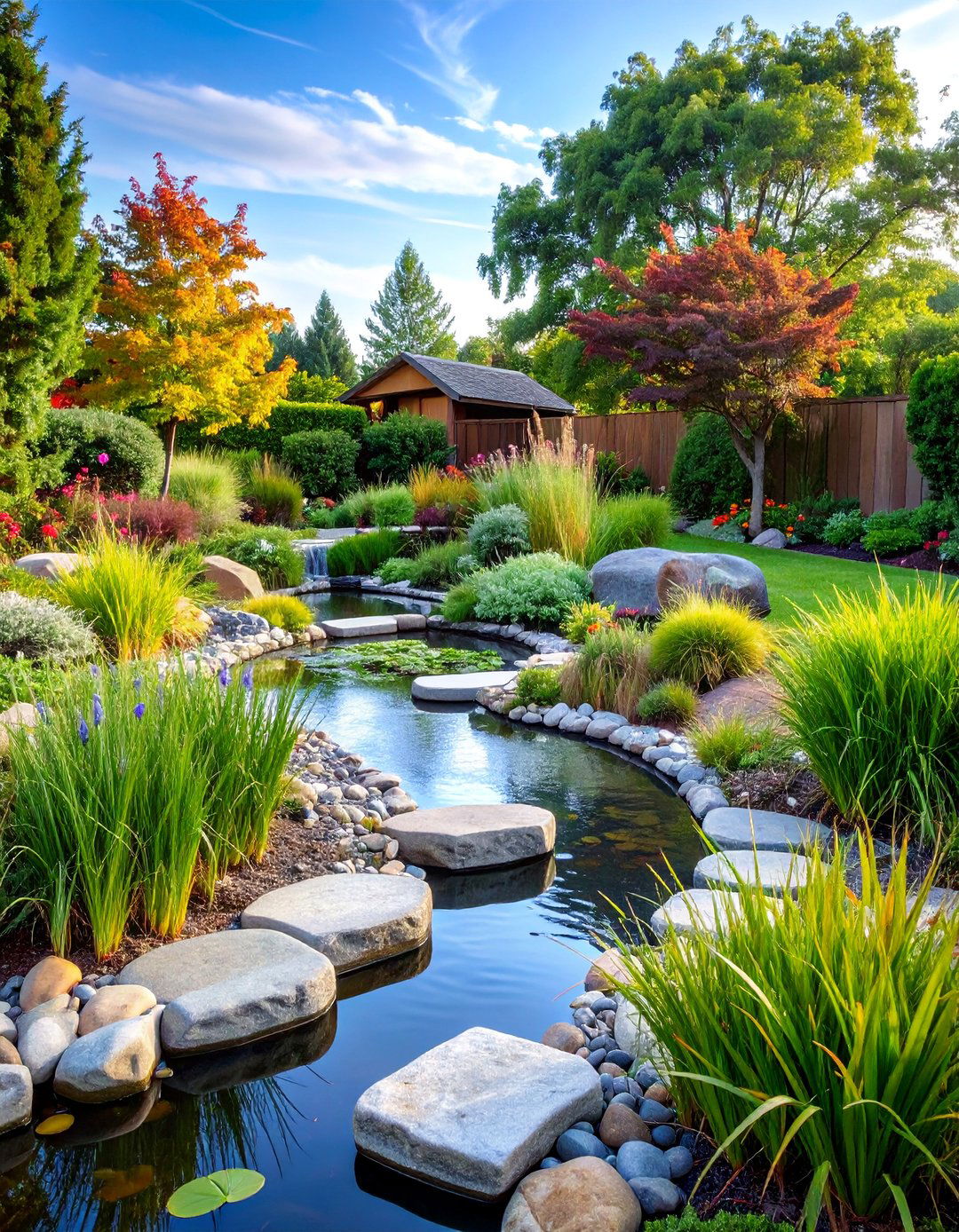
Rain gardens manage stormwater runoff while creating beautiful planted areas that showcase water-loving plants and sustainable gardening practices. This environmentally conscious layout features shallow depressions that collect rainwater from roofs, driveways, and other impervious surfaces. Native plants with deep root systems filter pollutants while preventing erosion and flooding. The design incorporates berms, swales, and planted channels that direct water flow through the landscape. Plant selections include wetland species, native grasses, and flowering perennials that tolerate both wet and dry conditions. Decorative elements like river rocks and driftwood enhance the natural aesthetic. This layout addresses environmental concerns while creating dynamic gardens that change with weather patterns. Rain gardens reduce water bills, prevent runoff problems, and provide habitat for wildlife while demonstrating responsible land stewardship.
16. Butterfly Garden Layout with Pollinator-Friendly Plants
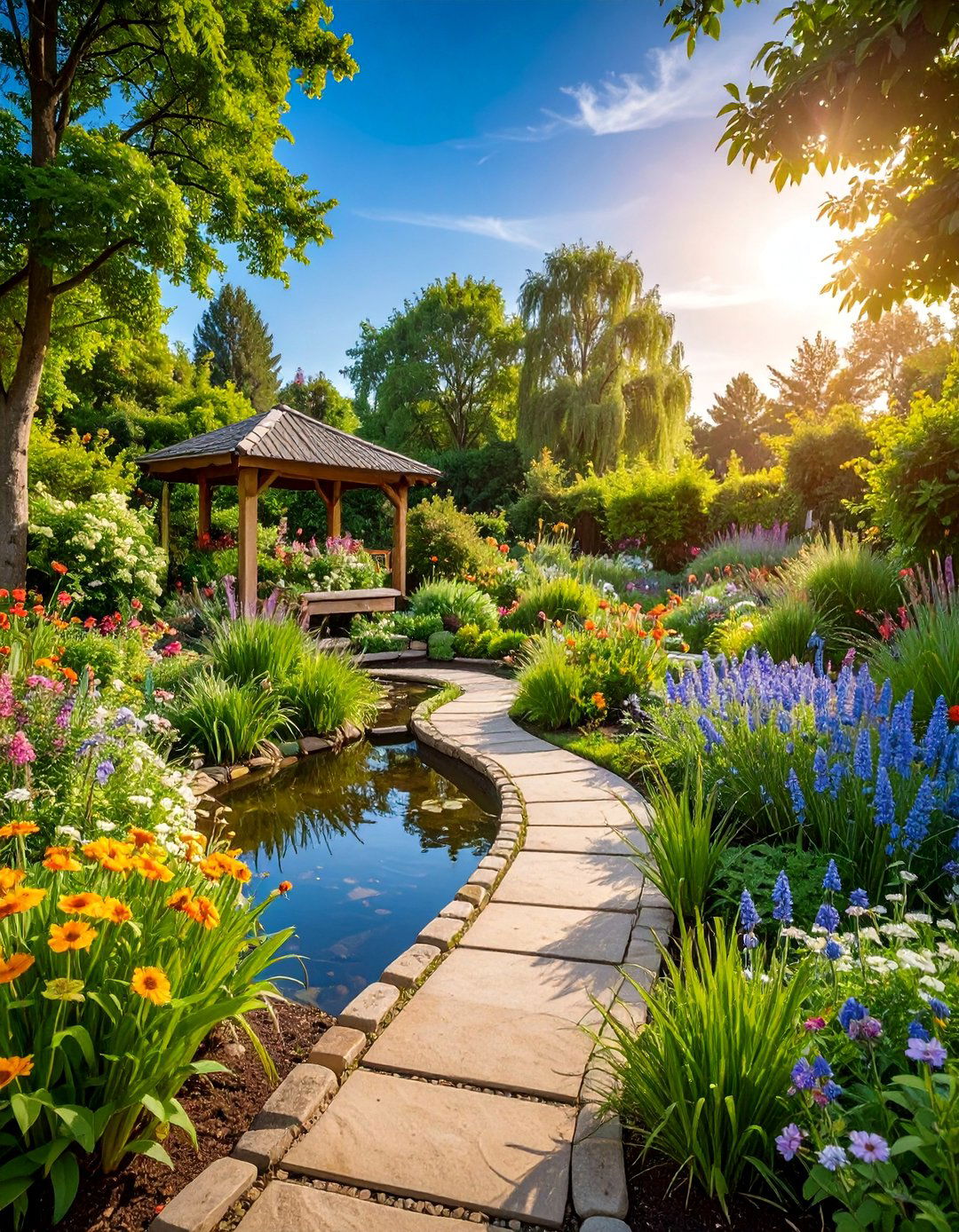
Butterfly gardens create habitats that support pollinators through carefully selected plants that provide nectar, host plants for caterpillars, and protective shelter. This conservation-focused layout groups plants according to bloom times, ensuring continuous flower succession throughout the growing season. The design incorporates sunny locations protected from strong winds, shallow water sources, and basking areas where butterflies can warm themselves. Native plants form the foundation, supplemented with non-invasive flowering species that attract various butterfly species. Plant heights create layered compositions with tall background plants, medium-height focal specimens, and low groundcover plants. This layout appeals to nature lovers who want to support declining pollinator populations while enjoying the beauty and movement butterflies bring to gardens. The ecological approach creates educational opportunities while demonstrating environmental stewardship through gardening practices.
17. Rock Garden Layout with Alpine and Succulent Plants

Rock gardens showcase drought-tolerant plants in naturalistic settings that celebrate the beauty of stone and specialized plant communities. This low-maintenance layout incorporates various stone sizes, from large boulders to small pebbles, creating dramatic landscapes that mimic alpine or desert environments. Plant selections emphasize succulents, alpine perennials, and ornamental grasses that thrive in well-drained, mineral-rich soils. The design considers natural rock formations and slope orientations to create authentic-looking compositions. Pathways wind between rock features, providing access and viewing opportunities while preventing soil compaction. This layout works well on slopes, in sandy soils, or areas with challenging growing conditions. Rock gardens require minimal water and maintenance once established while providing year-round structure and interest through varied textures, forms, and seasonal changes.
18. Children's Garden Layout with Interactive Elements

Children's gardens create engaging outdoor spaces that encourage learning, exploration, and hands-on gardening experiences through age-appropriate features and plant selections. This educational layout incorporates raised beds at child-friendly heights, wide pathways for safe movement, and clearly defined growing areas for individual or group projects. Plant choices emphasize fast-growing varieties, sensory plants with interesting textures or fragrances, and crops that children enjoy eating. The design includes interactive elements like sandbox areas, simple water features, and seating spaces for outdoor classrooms. Themed sections might focus on pizza gardens with tomatoes and herbs, butterfly gardens with host plants, or fairy gardens with miniature plants and decorations. This layout creates positive associations with gardening while teaching responsibility, natural sciences, and healthy eating habits through direct experience.
19. Moon Garden Layout with Evening-Blooming Plants

Moon gardens create enchanting nighttime displays through white and pale-colored flowers that glow in moonlight and evening illumination. This romantic layout features plants that open their blooms or release fragrances during evening hours, creating gardens designed for nighttime enjoyment. White varieties of familiar flowers like roses, peonies, and lilies combine with night-blooming species such as moonflowers, four o'clocks, and evening primrose. The design incorporates seating areas positioned to enjoy views and fragrances while pathways provide safe navigation in low light. Reflective elements like light-colored gravel or pale stone surfaces enhance luminosity. This specialized layout appeals to gardeners who enjoy evening garden time or want to create spaces for nighttime entertaining. Moon gardens offer unique sensory experiences that differ completely from traditional daytime garden displays.
20. Cutting Garden Layout with Flower Production Focus

Cutting gardens prioritize flower production for indoor arrangements through organized layouts that maximize bloom quantity and extend harvest seasons. This productive layout arranges flowers in rows or blocks that facilitate easy cutting, maintenance, and succession planting. The design separates cutting areas from display gardens, allowing for intensive management without affecting ornamental areas. Plant selections emphasize varieties bred for long stems, good vase life, and continuous production rather than landscape display. The layout includes support systems for tall flowers, pathways for cart access, and work areas for processing and conditioning cut flowers. Succession planting ensures continuous blooms throughout the growing season while companion plants attract beneficial insects. This specialized approach appeals to flower arrangers, event planners, or anyone who enjoys fresh flowers indoors while maintaining productive outdoor spaces dedicated to harvest rather than display.
21. Sensory Garden Layout with Textural and Aromatic Plants
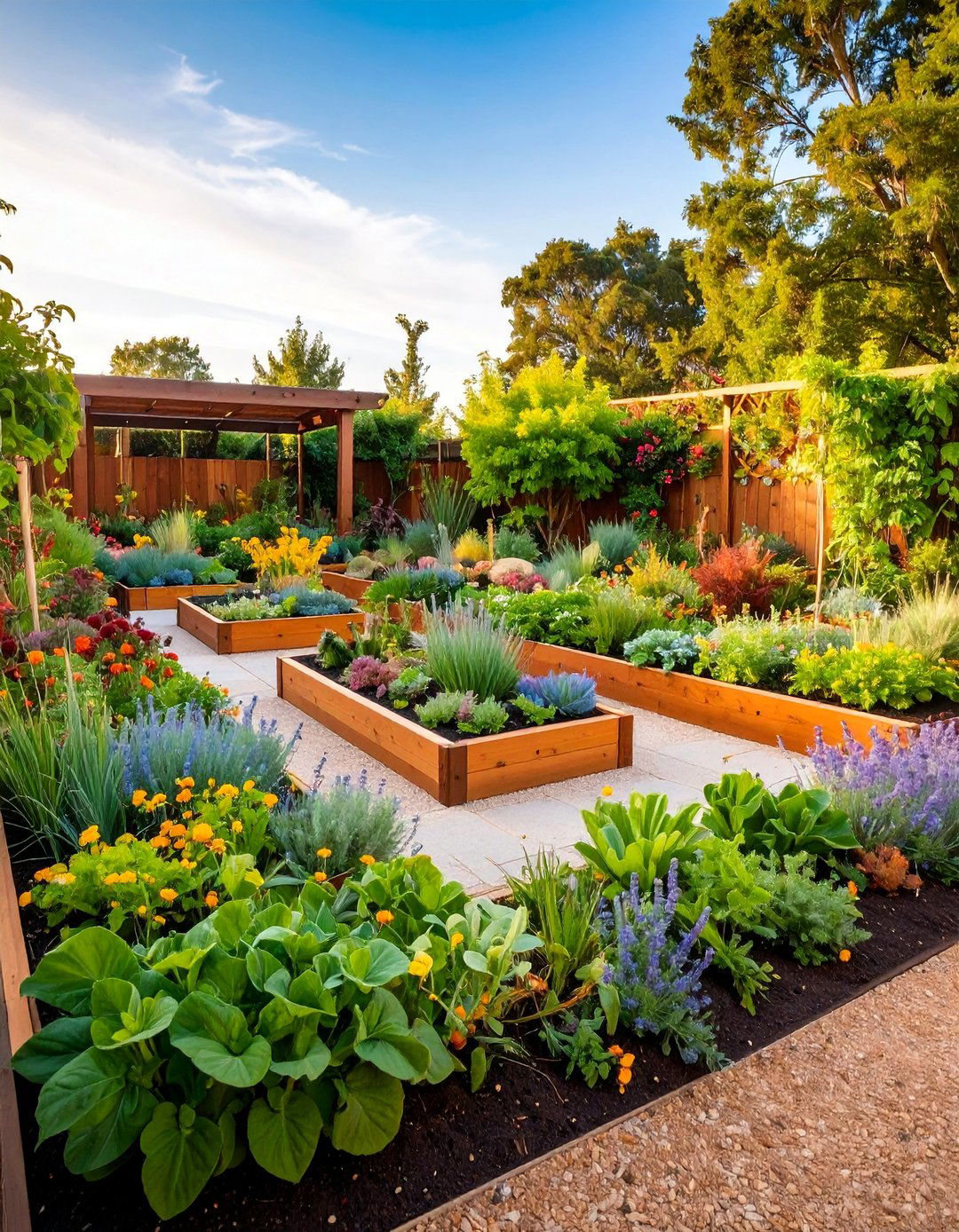
Sensory gardens engage multiple senses through carefully selected plants and features that provide diverse textures, fragrances, sounds, and visual experiences. This therapeutic layout emphasizes plants with interesting tactile qualities like lamb's ear's soft leaves, ornamental grasses that rustle in breezes, and herbs that release fragrances when touched. The design incorporates raised beds for accessibility, wide pathways for easy navigation, and seating areas that encourage lingering and exploration. Water features add sound elements while wind chimes and ornamental grasses provide gentle movement. Plant selections consider seasonal changes in texture, color, and fragrance to maintain interest throughout the year. This layout appeals to gardeners interested in therapeutic horticulture, accessibility, or creating spaces that engage visitors through multiple sensory experiences rather than purely visual appreciation.
22. Wildlife Habitat Garden Layout with Native Plant Communities
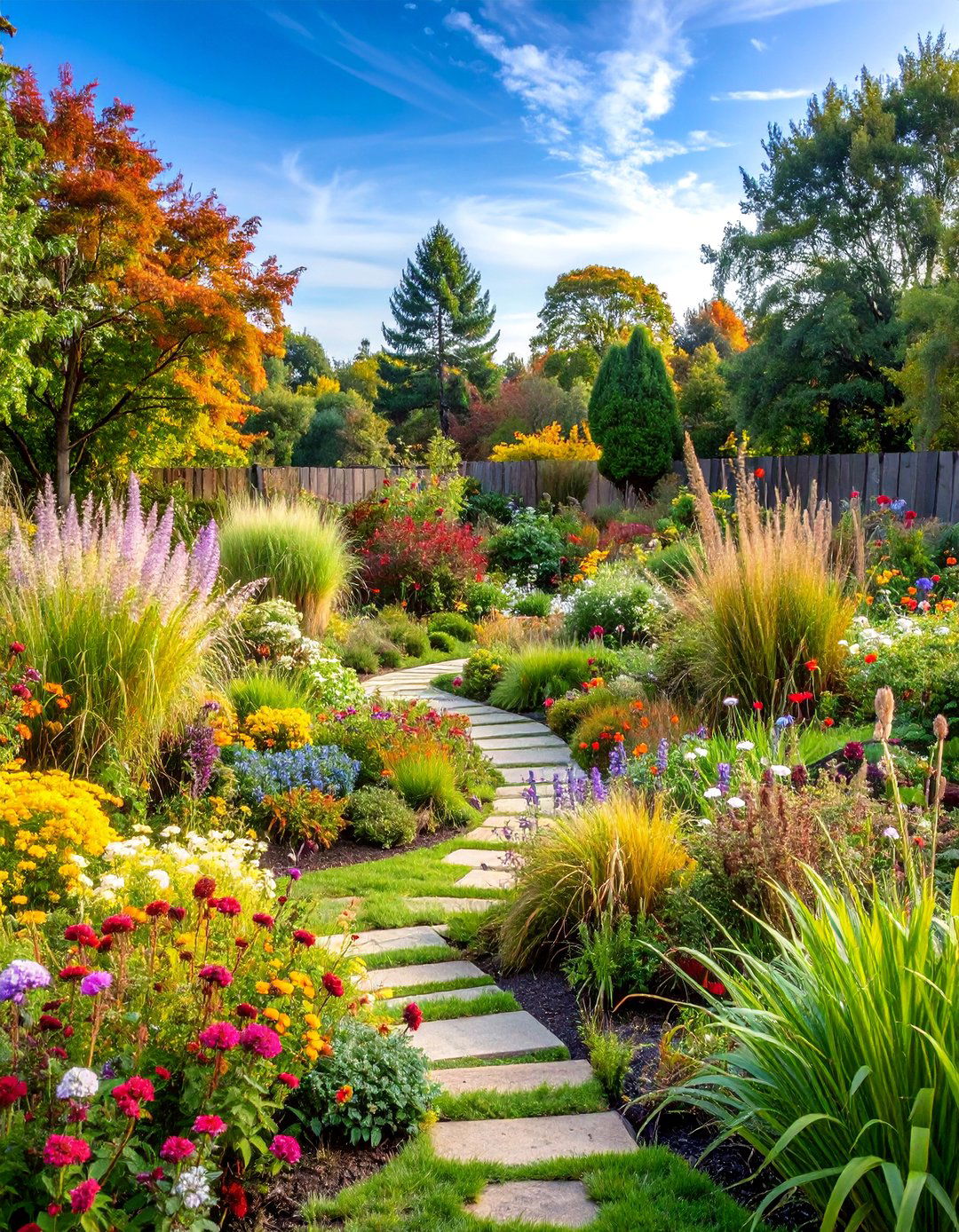
Wildlife habitat gardens support local ecosystems through native plant communities that provide food, shelter, and nesting sites for birds, beneficial insects, and small animals. This conservation-focused layout groups plants according to natural community associations, creating authentic habitat areas that function as mini-ecosystems. The design incorporates various habitat types including meadow areas, shrub borders, and woodland edges that support different wildlife species. Water features, brush piles, and nesting boxes enhance habitat value while native plants provide seasonal food sources through berries, seeds, and nectar. The layout considers wildlife movement patterns and seasonal needs while minimizing human disturbance in critical areas. This approach appeals to environmentally conscious gardeners who want to support biodiversity while enjoying the wildlife activity their gardens attract throughout the seasons.
23. Four-Season Garden Layout with Year-Round Interest

Four-season gardens provide continuous visual interest through strategic plant selections and design elements that create attractive displays throughout the entire year. This comprehensive layout combines spring flowering bulbs, summer perennials, autumn foliage plants, and winter interest trees and shrubs in compositions that transition seamlessly between seasons. The design considers bloom succession, foliage changes, fruit production, and bark characteristics to maintain appeal during all weather conditions. Evergreen plants provide structure while deciduous species offer seasonal variety. Hardscape elements like stone features, architectural plants, and garden art maintain presence during dormant seasons. This holistic approach requires careful planning but rewards gardeners with constantly changing displays that eliminate off-season dullness. The layout appeals to gardeners who want maximum return on their gardening investment through spaces that provide beauty and interest regardless of season.
24. Edible Landscape Layout with Food-Producing Plants

Edible landscapes integrate food production into ornamental garden designs through attractive arrangements of fruit trees, berry bushes, vegetables, and herbs that provide both beauty and sustenance. This practical layout disguises productive plants within landscape compositions, using attractive edible varieties that serve dual purposes. Fruit trees provide shade and seasonal interest while producing crops, berry bushes create attractive borders while yielding harvests, and vegetables contribute color and texture to mixed plantings. The design considers mature plant sizes, harvest timing, and maintenance needs while creating visually appealing compositions. This approach appeals to gardeners who want to maximize their property's productivity while maintaining attractive landscapes. Edible landscaping reduces grocery bills, ensures fresh organic produce, and creates educational opportunities while proving that productive gardens can be as beautiful as purely ornamental ones.
25. Contemporary Minimalist Garden Layout with Architectural Elements

Contemporary minimalist gardens achieve sophisticated simplicity through restrained plant palettes, clean geometric lines, and emphasis on architectural materials and forms. This modern layout features large-scale hardscape elements, sculptural plants used as living architecture, and carefully edited plant selections that create maximum impact through repetition and contrast. The design emphasizes negative space as much as planted areas, using restraint to create powerful visual statements. Materials include concrete, steel, glass, and natural stone combined with architectural plants like ornamental grasses, succulents, and specimen trees with strong structural qualities. The layout requires precise maintenance to preserve clean lines and intentional compositions. This approach appeals to design-conscious gardeners who appreciate contemporary aesthetics and want outdoor spaces that complement modern architecture while requiring minimal maintenance through thoughtful plant selection and design principles.
Conclusion:
Choosing the right garden layout transforms your outdoor space into a purposeful, beautiful environment that reflects your personal style and meets your practical needs. Whether you prefer the structured elegance of formal designs, the abundant charm of cottage gardens, or the serene simplicity of contemporary minimalist approaches, each layout offers unique benefits and aesthetic qualities. Consider your lifestyle, maintenance preferences, and long-term goals when selecting from these diverse design approaches. The most successful gardens combine thoughtful planning with personal expression, creating outdoor spaces that evolve and mature over time while providing years of enjoyment, productivity, and connection with nature.


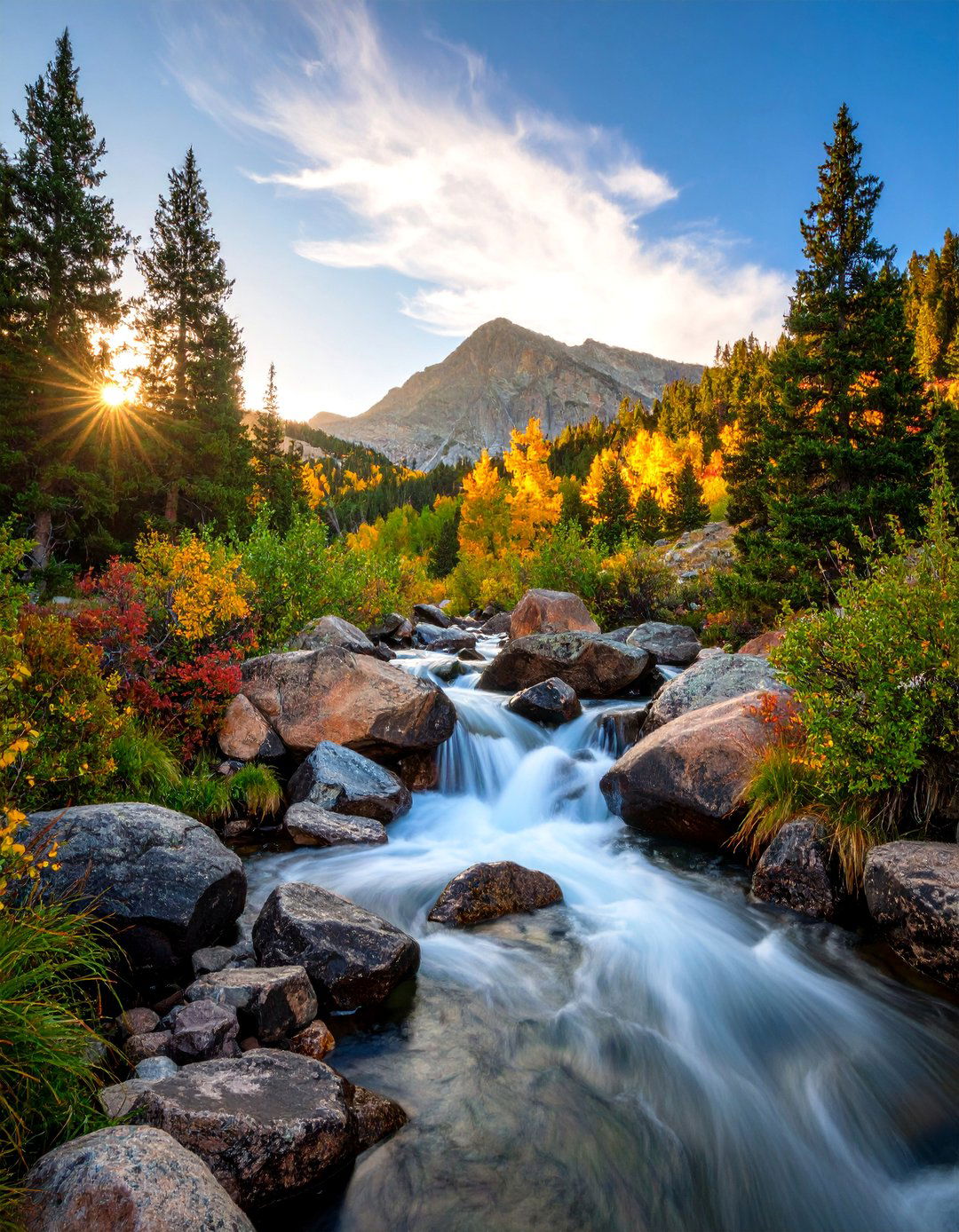
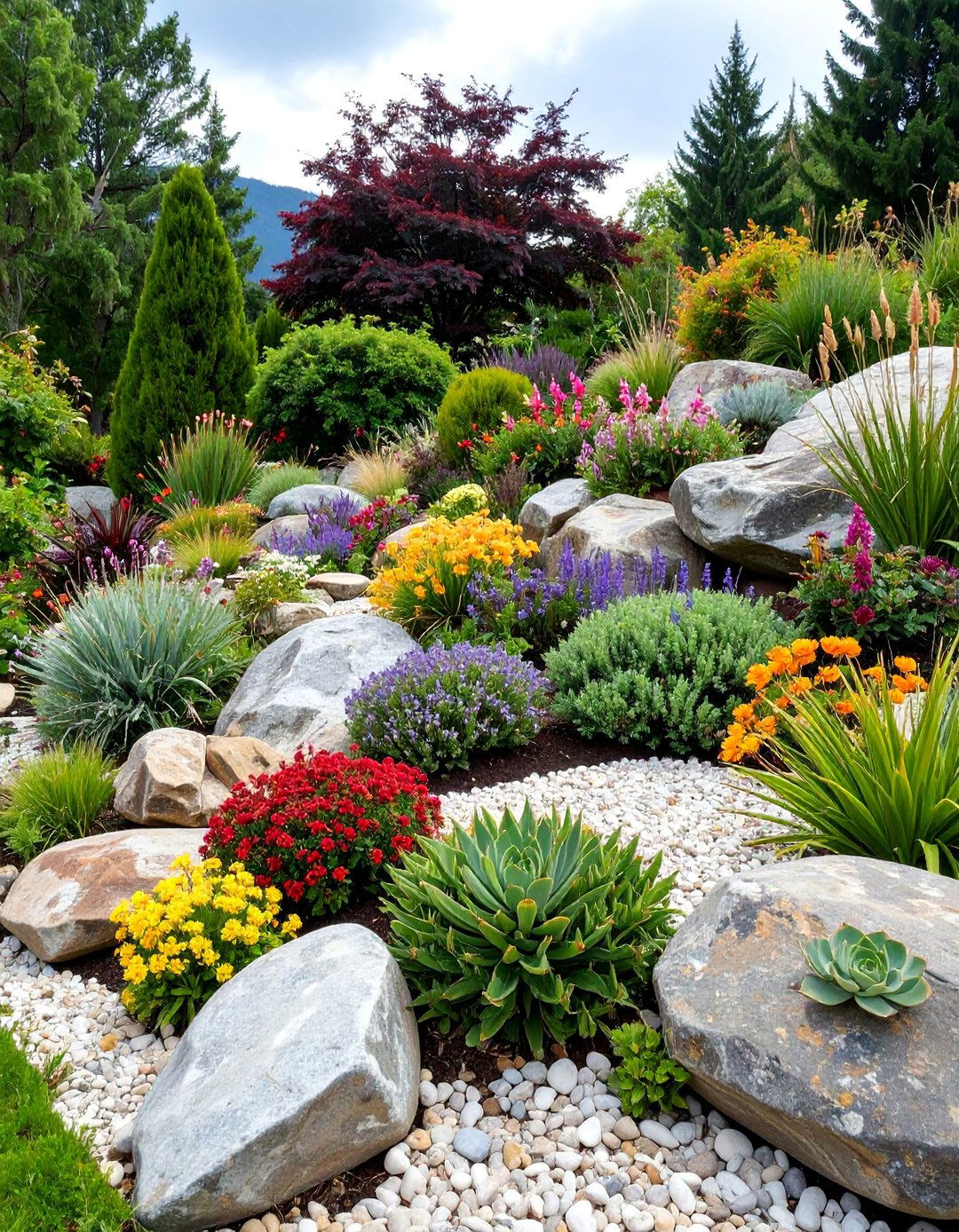
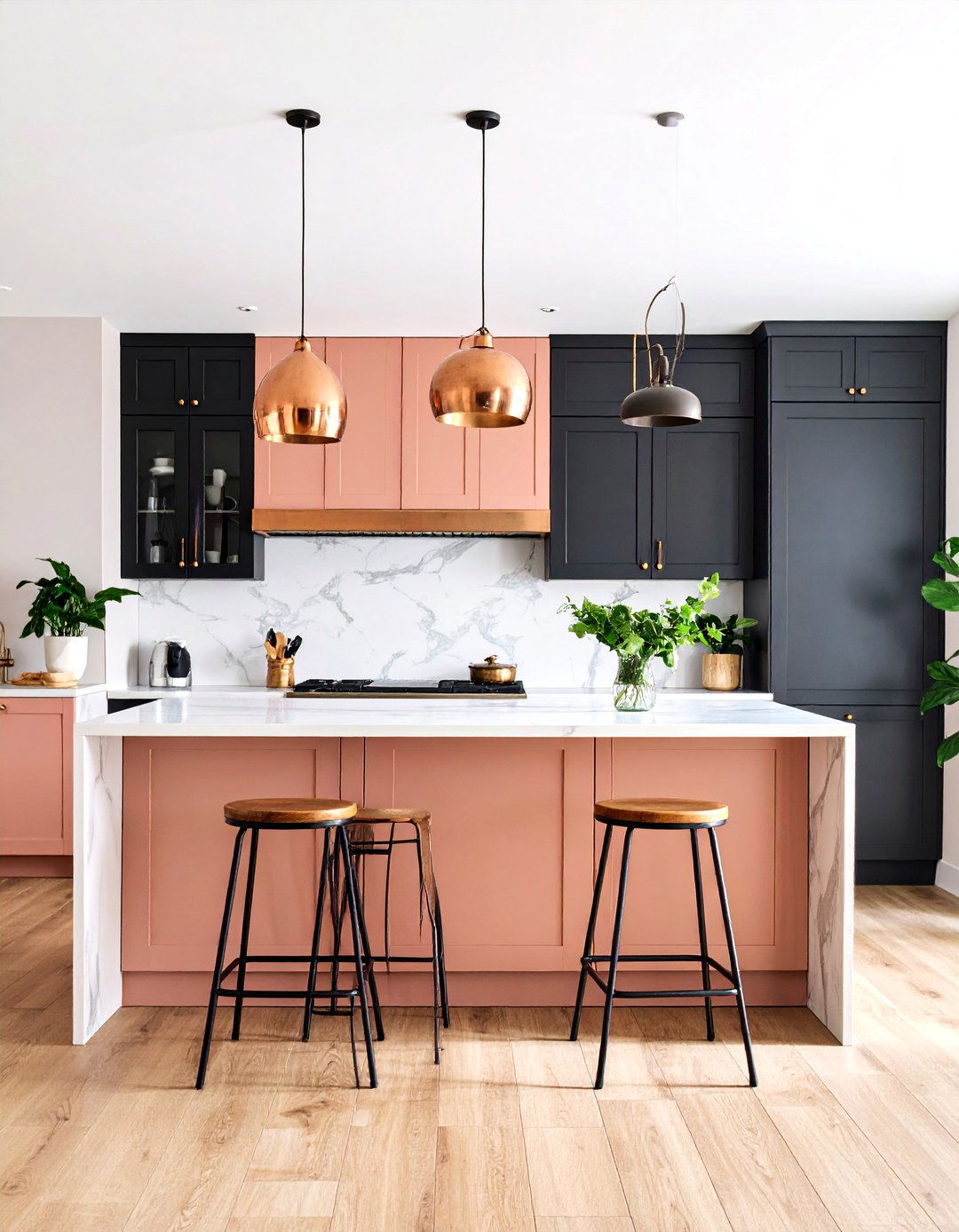

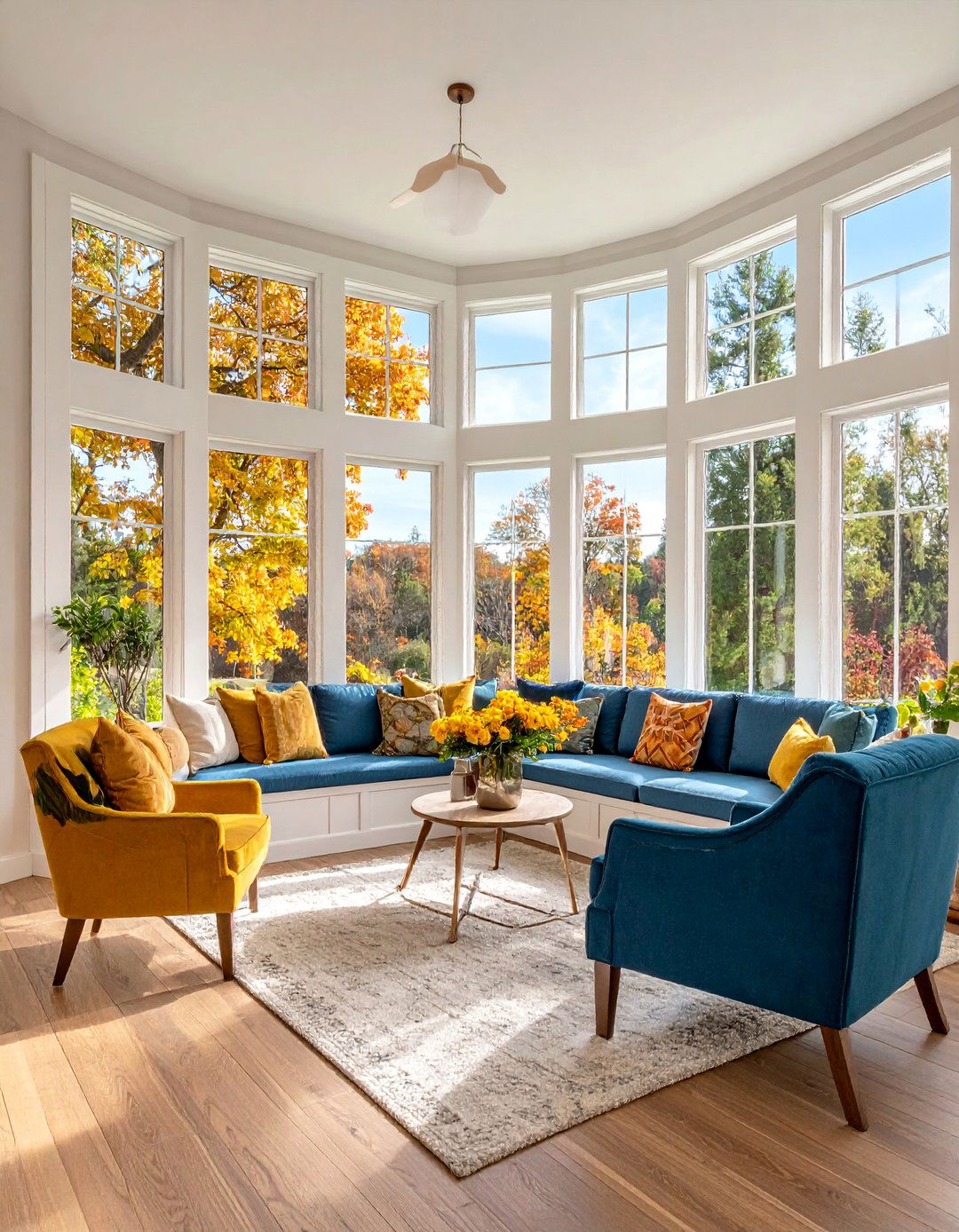


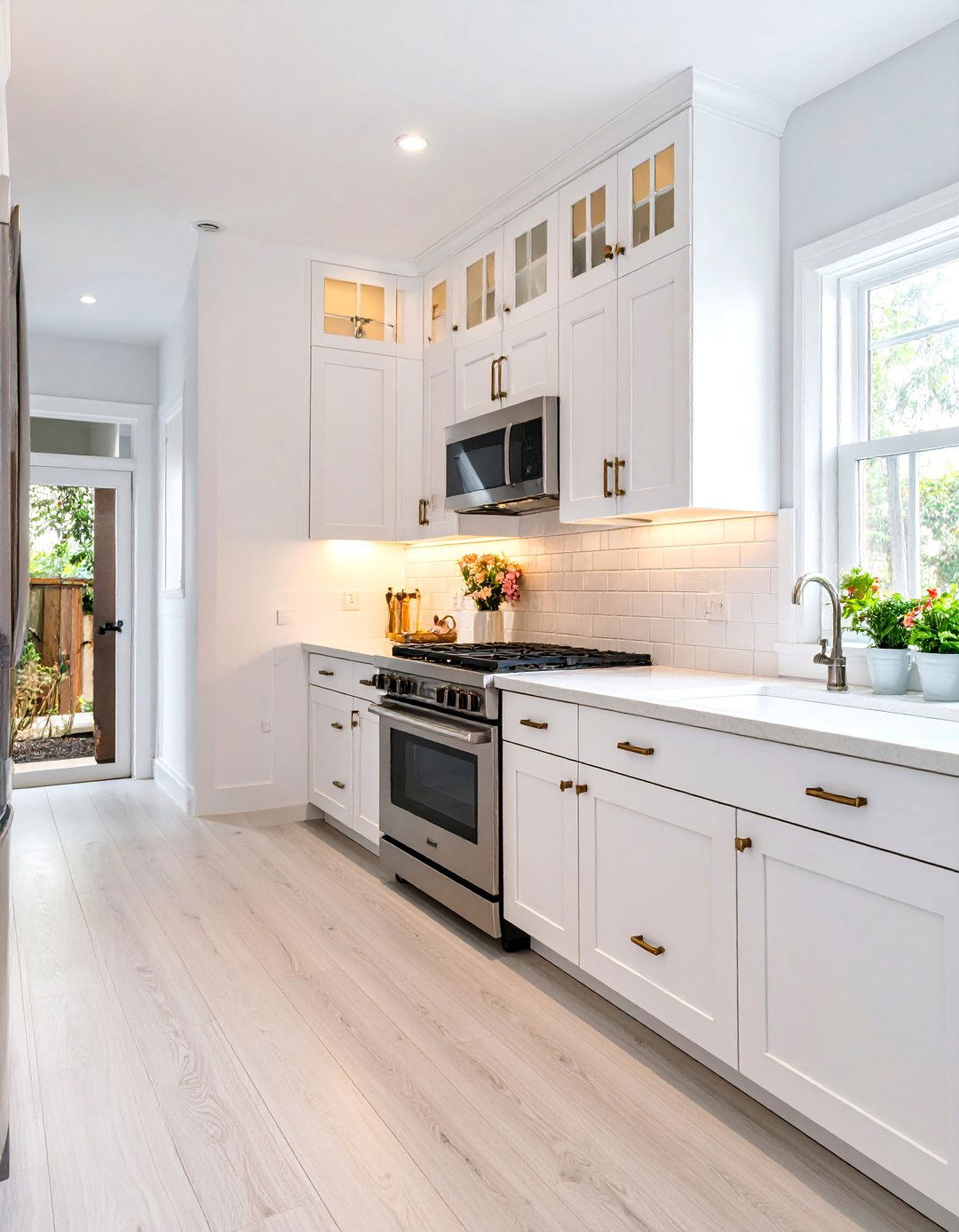
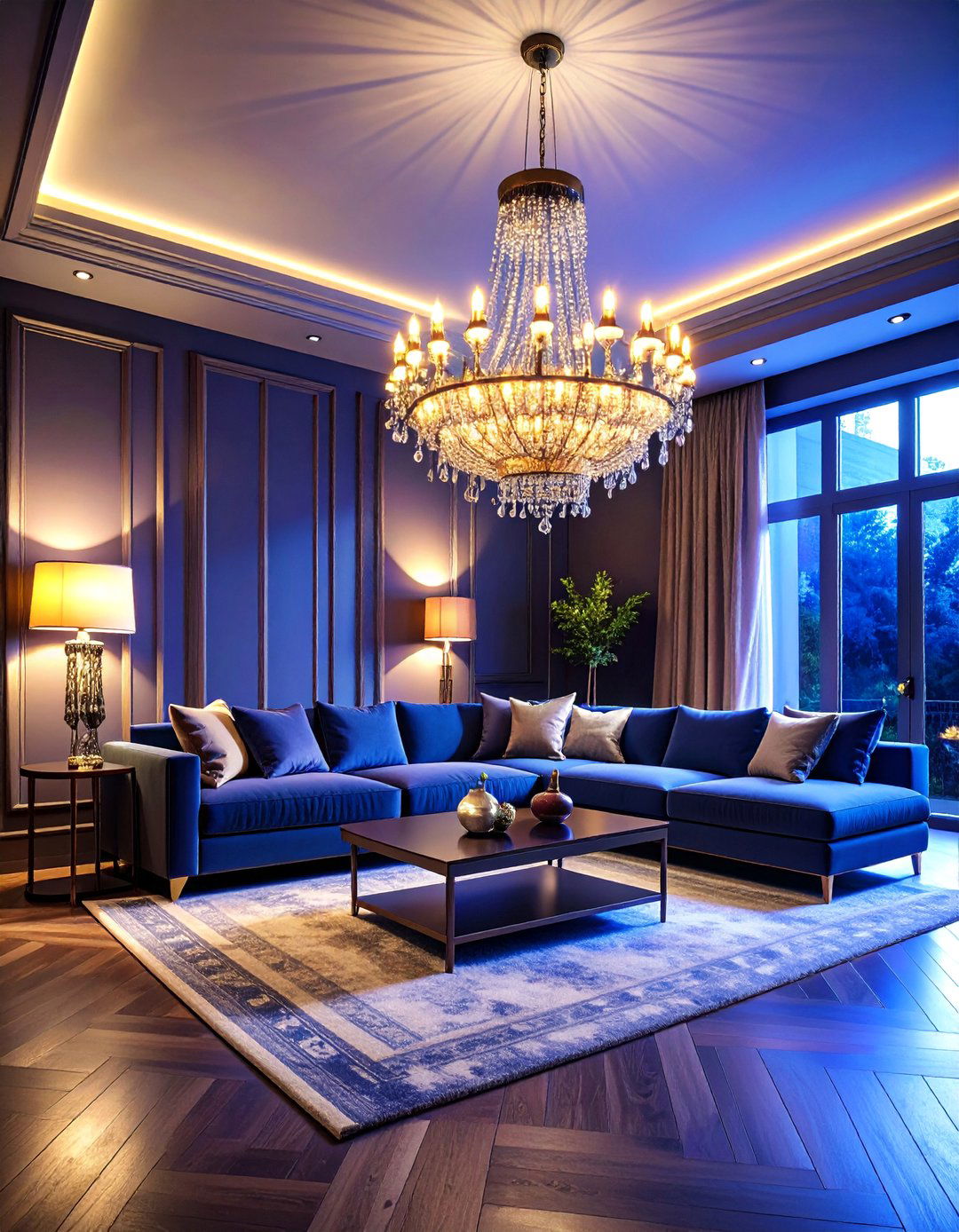



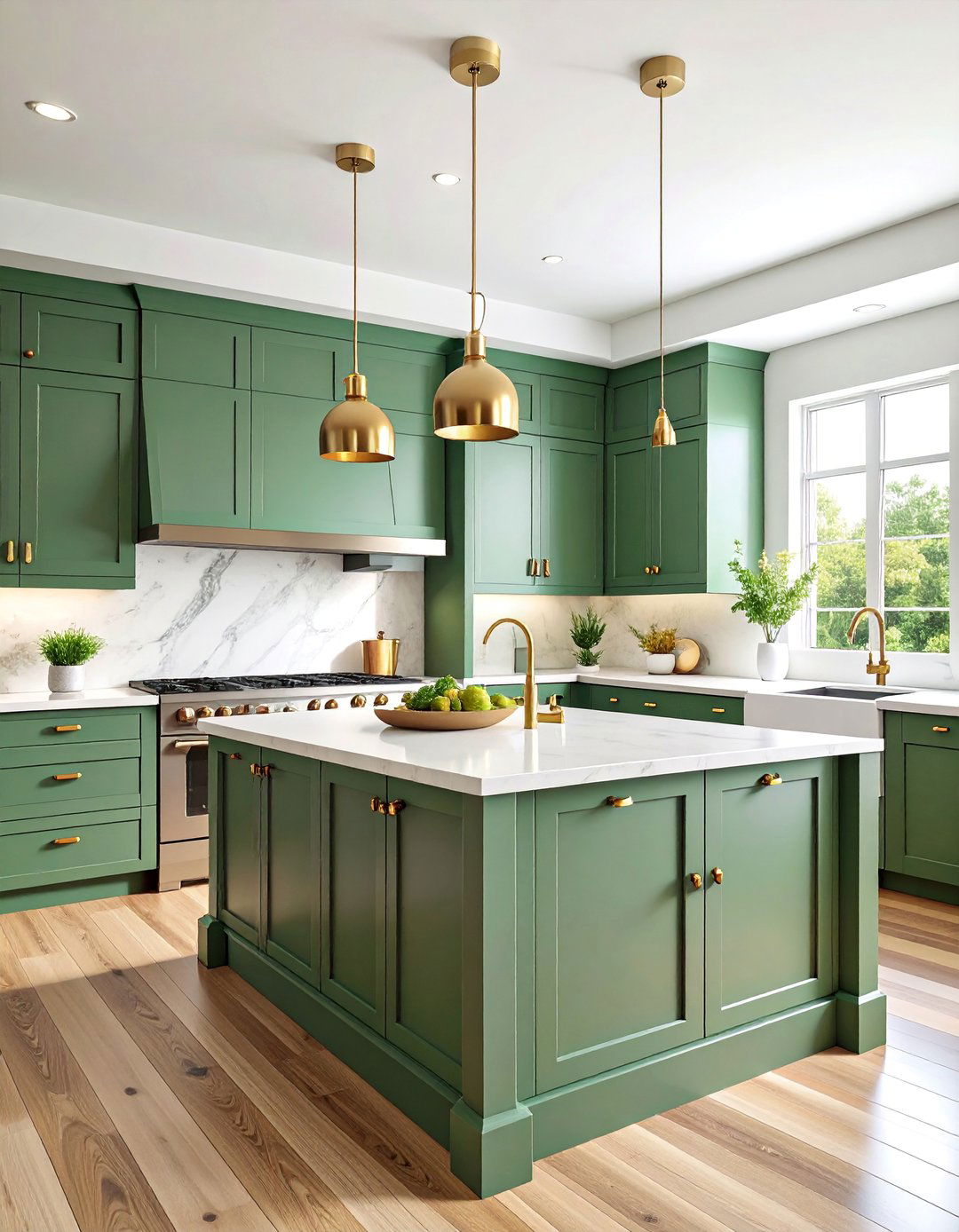
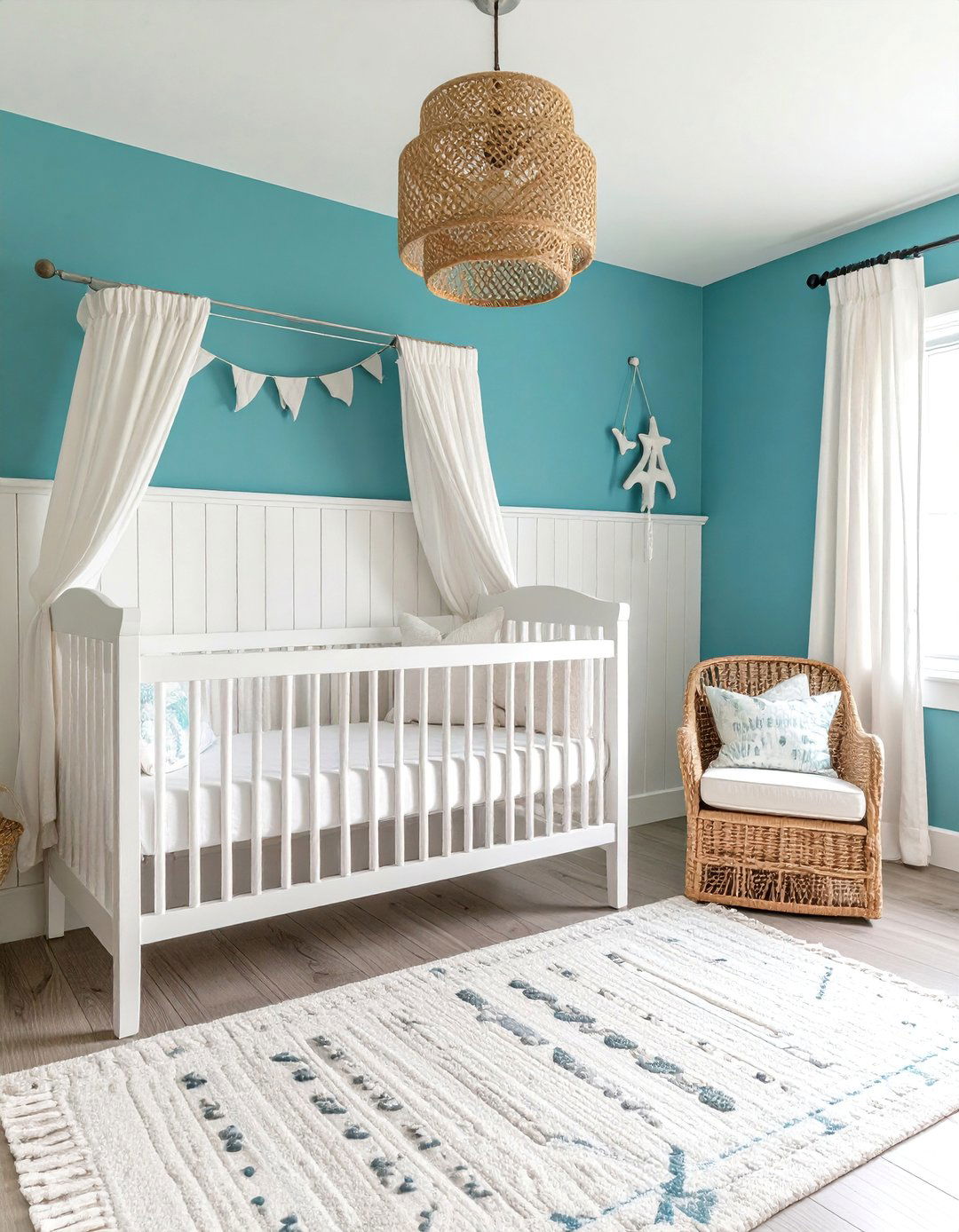
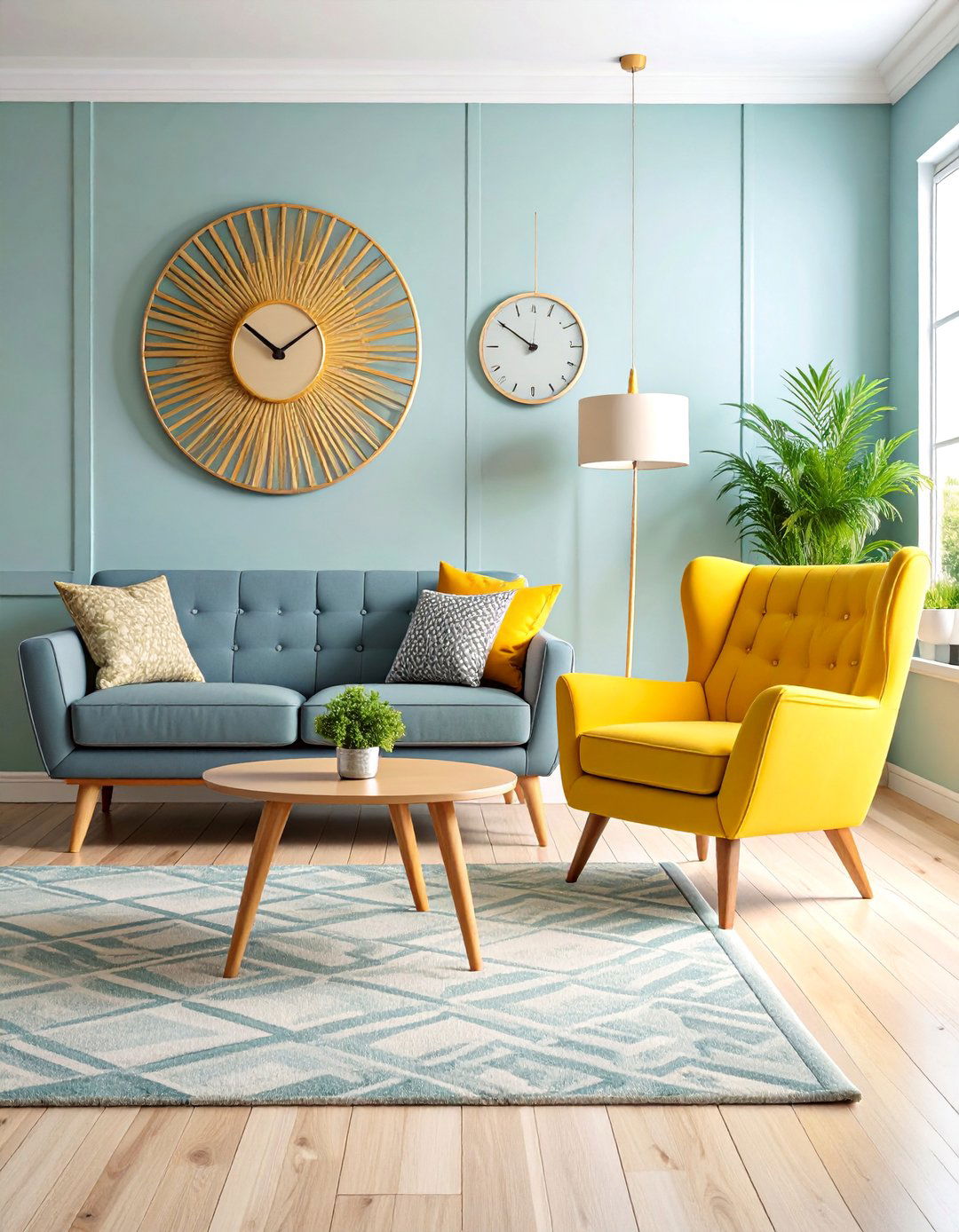

Leave a Reply